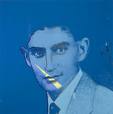Andy Warhol, Ugo Rondinone. Review by Andrew Graham-Dixon.
In 1980, after a decade spent producing the vapid commissioned portraits of the rich and the famous that did so much to debase the currency of his later art, Andy Warhol decided to change tack. The idea was sparked by a conversation with his dealer, Ronald Feldman, who suggested that the artist produce a print portfolio memorialising the Jewish contribution to twentieth-century civilisation. Feldman’s proposition was that Warhol should create a series of ten portraits, entitled Ten Jews of the Twentieth-Century. Somewhat to his surprise, Warhol embraced the suggestion enthusiastically, and the prints were soon completed. The artist was so pleased with the results that he decided to produce a series of large scale paintings – created using his customary technique of retouched screenprints – based on those images. Three minutely differing paintings of each subject, thirty pictures in all, were exhibited at the Jewish Museum in New York in the autumn of 1980.
Hung around the circumference of a circular gallery, they generated an instant controversy (as Warhol must have hoped they would). Carrie Rickey, reviewing the exhibition in the pages of the American art magazine Artforum, welcomed the artist’s return to meaningful content and discerned in the works “an unexpected mix of cultural anthropology, portraiture and celebration of intelligentsia”. Hilton Kramer, in the New York Times, proclaimed that “the show is vulgar, it reeks of commercialism and its contribution to art is nil”, adding, for good measure, that “the way it exploits its Jewish subjects without showing the slightest grasp of their significance is offensive.” As Kramer cynically predicted, the three sets of ten paintings were subsequently sold for large sums of money. Two of them ended up, respectively, in the Andy Warhol Museum and...


